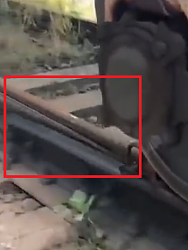Train track change up close.
Previously:
Train track derailers - photos
Railway hydraulic retarders - GIF
Railway detonators - GIF
Train changes track gauges - GIF
Train axle counter - GIF


Train track change up close.
Previously:
Train track derailers - photos
Railway hydraulic retarders - GIF
Railway detonators - GIF
Train changes track gauges - GIF
Train axle counter - GIF

New plans added on 11/20: Click here for 2,589 plans for homemade tools.
nova_robotics (May 5, 2024), tuchie (May 5, 2024)
What are they doing here? It looks like the shoe is meant to slow or stop the car. But then it drops off at the de-rail. But why didn't the first truck de-rail??
Carl.
I don't think they are changing tracks. Now I think this is a classification hump yard. Cars are pushed over a small hump or hill to roll down to a new siding. If a string of cars is going too fast a Switchman will put a skate in front of a wheel. Then the odd track is a spot to spit the skate out. Notice at the end there is another skate on top of a section of tie. Usually there are braking pads that close on the outside edges of the wheels that the Hump Operator (or the computer) controls to slow cars.
Carl.
https://en.wikipedia.org/wiki/Classification_yard

Last edited by carl blum; May 1, 2024 at 04:28 PM. Reason: More Observations.
Jon (May 1, 2024)
This does not look like a set of points that normally change trains direction from one track to another. I do see that it pushes the wheel over, but as both tracks are a single track why not have a normal but joint? Maybe we're just not seeing enough of the bigger picture hence difficult to comprehend the logic.
Hi Gang:
Check Wikipedia to understand what is happening: https://en.wikipedia.org/wiki/Classification_yard
The answer is in paragraph #2 of the "Hump" section.
Carl.
albertq (May 3, 2024)
Thanks for the great link, Carl. Your reference to the hump yard indicates the skate is being used as a brake or retarder which may not be the case here. The pictures clearly show the skate is moving the wheel over from one track to the other. One track is shiny and used and the other appears to be rusty. But there are certainly questions of what is actually going on. The tracks are inline with each other, yet one has weeds and appears unused and the other appears well maintained. I guess its a siding (resting spot in the classification system) that cars never quite get too.
Skate is engaged and wheel is fully on whole width of track.
Skate engaged and wheel is starting to move to the side. Notice the red lines show the wheel displacement sideways. About 1/2 of the rail width.
Skate engaged and wheel moved to the right, almost completely off of the track.
Skate has just dropped off (see the shiny part) and the wheel has transferred over and is fully on, i.e., inline with the new track.
Thanks for the reference link. It was interesting.
Last edited by Saltfever; May 4, 2024 at 11:08 PM.
Last edited by Saltfever; May 4, 2024 at 11:05 PM.
HI:
The track with a red "X" is a guard rail, and is never ridden on. It isn't connected to any rails at either end. This area is an escape for the Skate. If you look before and after this area there are only the normal two rails, left and right. If this were a turnout there would be four rails at the end. If the skate were forcing a change wouldn't they need a skate at each truck? That would be a lot of labor.
I wonder where this is filmed? The end of the truck bearings doesn't look like the USA style roller bearing package. That might be why they are using a labor intencive method rather that computer driven phenumatic retarders.
Carl.
Agree, the skate is not moving the wheel sideways. Watch in slo-mo if you can. That tapered, pointy end of the next rail is positioned right where the skate slides off. The flange of the wheel locates (or is guided) onto the pointy rail and that transitions the wheel over to be fully on the new rail. As you suggested the skate may be used as a retarder and only one is needed.


There are currently 1 users browsing this thread. (0 members and 1 guests)
Bookmarks